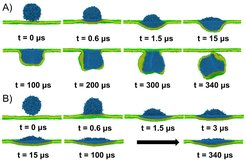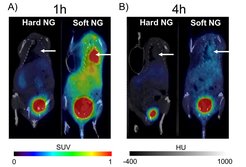Tuning the properties of drug carries to improve lifetime and distribution in patients’ bodies
Changing the elasticity of nanogels that can be used as carriers for the administration of various drugs in patients suffering from medical conditions like cancer improves their circulation time by evading immune cells.
Scientists at the Max Planck Institute for Medical Research in Heidelberg and their collaborators at the RWTH Aachen have shown the effects of tuning the mechanical properties of nanogels (NGs) on their overall distribution in the body. NGs are nanoscale soft gel particles that can be used as a carrier for the administration of various drugs in patients suffering from medical conditions like cancer. For delivery of the drug using a nanocarrier such as NGs, it is vital to design them in such a way that they become ‘invisible’ to the immune system and thus are prevented from being eliminated from the blood. The group demonstrates why and how small changes in the mechanical properties of the NGs prevent their uptake by the immune cells. PET/CT was used to show that by optimizing the NGs’ elasticity a significant enhancement in circulation half-life of the gel was achieved. Computer simulations confirmed the results and predicted the mechanism by which the NGs evaded the immune cells. Altogether, this work emphasizes the important role of mechanical properties such as the elasticity of the drug delivery carriers for better therapeutic efficacy. The findings were recently published in Angewandte Chemie.
Peptide receptor radionuclide therapy (PRRT) is used to treat solid tumors by delivering radiation that targets specific receptors highly expressed in the tumor cells compared to healthy cells. Although PRRT holds promise in nuclear medicine, it suffers from limitations such as toxic side effects for the liver and kidneys, which restrict the applied dose. To improve the efficacy of PRRT, nanocarriers such as NGs can be used. They are nanoscale soft gel particles that can be used as a carrier for the administration of various drugs in patients suffering from medical conditions like cancer. Their use can prevent non-specific organ accumulation, improve the distribution within the body, and thus enhance the therapeutic effects of the radionuclide. However, in doing so the main challenge the nanocarriers encounter is the immune system.
Evading immune cells

In this work, the researchers synthesized highly hydrophilic PEG-based NGs with an elasticity of 37KPa, which resembles soft jelly candies, but on a nanoscale. They show that uptake of such soft NG was drastically reduced by the immune cells. The highly hydrophilic nature of these PEG-based NGs lead to low adhesive interaction with the cell membrane, and due to the low elastic modulus of the NGs their contact area with the cell membrane increases, leading to deformation and spreading of the NGs on the cell membrane of immune cells. This large deformability of soft NGs requires more energy for cellular engulfment and thus prevents their uptake. ”Thus modulation of mechanical property can be used as a tool to design different types of nanocarriers for drug delivery application for better therapeutic outcome” says Smriti Singh, Departmental Research Group Leader at the MPIMR.
In vivo evaluation

The NGs were labeled with a radionuclide, Gallium-68 (68Ga) and visualized using PET/CT in a mouse model. The result demonstrated enhanced circulation time of the soft NGs compared to their stiffer counterparts. The researchers also observed the ability of soft NGs to squeeze through the splenic pores owing to its deformable nature resulting in fast renal clearance. ”In a follow-up study, these NGs will be radiolabeled with Lutetium-177 (177Lu) to target the somatostatin receptor 2 (SStR2) expressed in neuroendocrine tumors and will be further investigated for kidney toxicity” says Prachi Desai, who is a PhD student working with Smriti Singh and the first author on the paper. .
The group strongly believes that modulating the stiffness of nanocarriers will potentially improve the delivery of drugs and minimize the side-effects, especially in cancer treatments where chemotherapy and endogenous radiotherapy are used.

